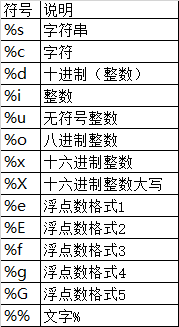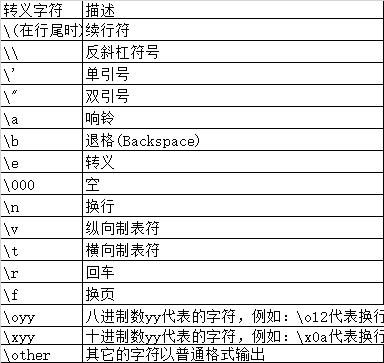Python的格式化输出----%用法和format用法
%用法 实现格式化
1、整数的输出
%o —— oct 八进制
%d —— dec 十进制
%x —— hex 十六进制
1 >>> print('%o' % 20) 2 24 3 >>> print('%d' % 20) 4 20 5 >>> print('%x' % 20) 6 14
2、浮点数输出
%f ——保留小数点后面六位有效数字
%.3f,保留3位小数位
%e ——保留小数点后面六位有效数字,指数形式输出
%.3e,保留3位小数位,使用科学计数法
%g ——在保证六位有效数字的前提下,使用小数方式,否则使用科学计数法
%.3g,保留3位有效数字,使用小数或科学计数法
1 >>> print('%f' % 1.11) # 默认保留6位小数 2 1.110000 3 >>> print('%.1f' % 1.11) # 取1位小数 4 1.1 5 >>> print('%e' % 1.11) # 默认6位小数,用科学计数法 6 1.110000e+00 7 >>> print('%.3e' % 1.11) # 取3位小数,用科学计数法 8 1.110e+00 9 >>> print('%g' % 1111.1111) # 默认6位有效数字 10 1111.11 11 >>> print('%.7g' % 1111.1111) # 取7位有效数字 12 1111.111 13 >>> print('%.2g' % 1111.1111) # 取2位有效数字,自动转换为科学计数法 14 1.1e+03
3、字符串输出
%s
%10s——右对齐,占位符10位
%-10s——左对齐,占位符10位
%.2s——截取2位字符串
%10.2s——10位占位符,截取两位字符串
1 >>> print('%s' % 'hello world') # 字符串输出 2 hello world 3 >>> print('%20s' % 'hello world') # 右对齐,取20位,不够则补位 4 hello world 5 >>> print('%-20s' % 'hello world') # 左对齐,取20位,不够则补位 6 hello world 7 >>> print('%.2s' % 'hello world') # 取2位 8 he 9 >>> print('%10.2s' % 'hello world') # 右对齐,取2位 10 he 11 >>> print('%-10.2s' % 'hello world') # 左对齐,取2位 12 he
4、 其他
(1)字符串格式代码
(2)常用转义字符
format用法 实现格式化
1.位置匹配
(1)不带编号,即“{}”
(2)带数字编号,可调换顺序,即“{1}”、“{2}”
(3)带关键字,即“{a}”、“{tom}”
示例:
1 >>> print('{} {}'.format('hello','world')) # 不带字段 2 hello world 3 >>> print('{0} {1}'.format('hello','world')) # 带数字编号 4 hello world 5 >>> print('{0} {1} {0}'.format('hello','world')) # 打乱顺序 6 hello world hello 7 >>> print('{1} {1} {0}'.format('hello','world')) 8 world world hello 9 >>> print('{a} {tom} {a}'.format(tom='hello',a='world')) # 带关键字 10 world hello world
2.格式转换
'b' - 二进制。将数字以2为基数进行输出。
'c' - 字符。在打印之前将整数转换成对应的Unicode字符串。
'd' - 十进制整数。将数字以10为基数进行输出。
'o' - 八进制。将数字以8为基数进行输出。
'x' - 十六进制。将数字以16为基数进行输出,9以上的位数用小写字母。
'e' - 幂符号。用科学计数法打印数字。用'e'表示幂。
'g' - 一般格式。将数值以fixed-point格式输出。当数值特别大的时候,用幂形式打印。
'n' - 数字。当值为整数时和'd'相同,值为浮点数时和'g'相同。不同的是它会根据区域设置插入数字分隔符。
'%' - 百分数。将数值乘以100然后以fixed-point('f')格式打印,值后面会有一个百分号。
1 >>> print('{0:b}'.format(3)) 2 11 3 >>> print('{:c}'.format(20)) 4 5 >>> print('{:d}'.format(20)) 6 20 7 >>> print('{:o}'.format(20)) 8 24 9 >>> print('{:x}'.format(20)) 10 14 11 >>> print('{:e}'.format(20)) 12 2.000000e+01 13 >>> print('{:g}'.format(20.1)) 14 20.1 15 >>> print('{:f}'.format(20)) 16 20.000000 17 >>> print('{:n}'.format(20)) 18 20 19 >>> print('{:%}'.format(20)) 20 2000.000000%
3.进阶用法
1.进制转换>>> # format also supports binary numbers >>> "int: {0:d}; hex: {0:x}; oct: {0:o}; bin: {0:b}".format(42) 'int: 42; hex: 2a; oct: 52; bin: 101010' >>> # with 0x, 0o, or 0b as prefix: >>> "int: {0:d}; hex: {0:#x}; oct: {0:#o}; bin: {0:#b}".format(42) # 在前面加“#”,则带进制前缀 'int: 42; hex: 0x2a; oct: 0o52; bin: 0b101010'
2.左中右对齐及位数补全
(1)< (默认)左对齐、> 右对齐、^ 中间对齐、= (只用于数字)在小数点后进行补齐
(2)取位数“{:4s}”、"{:.2f}"等
>>> print('{} and {}'.format('hello','world')) # 默认左对齐 hello and world >>> print('{:10s} and {:>10s}'.format('hello','world')) # 取10位左对齐,取10位右对齐 hello and world >>> print('{:^10s} and {:^10s}'.format('hello','world')) # 取10位中间对齐 hello and world >>> print('{} is {:.2f}'.format(1.123,1.123)) # 取2位小数 1.123 is 1.12 >>> print('{0} is {0:>10.2f}'.format(1.123)) # 取2位小数,右对齐,取10位 1.123 is 1.12 >>> '{:<30}'.format('left aligned') # 左对齐 'left aligned ' >>> '{:>30}'.format('right aligned') # 右对齐 ' right aligned' >>> '{:^30}'.format('centered') # 中间对齐 ' centered ' >>> '{:*^30}'.format('centered') # 使用“*”填充 '***********centered***********' >>>'{:0=30}'.format(11) # 还有“=”只能应用于数字,这种方法可用“>”代替 '000000000000000000000000000011'
3.正负符号显示
>>> '{:+f}; {:+f}'.format(3.14, -3.14) # 总是显示符号 '+3.140000; -3.140000' >>> '{: f}; {: f}'.format(3.14, -3.14) # 若是+数,则在前面留空格 ' 3.140000; -3.140000' >>> '{:-f}; {:-f}'.format(3.14, -3.14) # -数时显示-,与'{:f}; {:f}'一致 '3.140000; -3.140000'
4.百分数%
>>> points = 19 >>> total = 22 >>> 'Correct answers: {:.2%}'.format(points/total) 'Correct answers: 86.36%'
5.时间
>>> import datetime >>> d = datetime.datetime(2010, 7, 4, 12, 15, 58) >>> '{:%Y-%m-%d %H:%M:%S}'.format(d) '2010-07-04 12:15:58'
6.逗号","分隔金钱,没以前进位
>>> '{:,}'.format(1234567890) '1,234,567,890'
7.占位符嵌套
>>> for align, text in zip('<^>', ['left', 'center', 'right']): ... '{0:{fill}{align}16}'.format(text, fill=align, align=align) ... 'left<<<<<<<<<<<<' '^^^^^center^^^^^' '>>>>>>>>>>>right' >>> >>> octets = [192, 168, 0, 1] >>> '{:02X}{:02X}{:02X}{:02X}'.format(*octets) 'C0A80001' >>> int(_, 16) # 官方文档给出来的,无法在IDLE复现 3232235521 >>> >>> width = 5 >>> for num in range(5,12): ... for base in 'dXob': ... print('{0:{width}{base}}'.format(num, base=base, width=width), end=' ') ... print() ... 5 5 5 101 6 6 6 110 7 7 7 111 8 8 10 1000 9 9 11 1001 10 A 12 1010 11 B 13 1011
8.占位符%s和%r
""" replacement_field ::= "{" [field_name] ["!" conversion] [":" format_spec] "}" conversion ::= "r" | "s" | "a" 这里只有三个转换符号,用"!"开头。 "!r"对应 repr();"!s"对应 str(); "!a"对应ascii()。 """ >>> "repr() shows quotes: {!r}; str() doesn't: {!s}".format('test1', 'test2') "repr() shows quotes: 'test1'; str() doesn't: test2" # 输出结果是一个带引号,一个不带
下表总结展示了 str.format() 格式化数字的多种方法:
数字 格式 输出 描述 3.1415926 {:.2f} 3.14 保留小数点后两位 3.1415926 {:+.2f} +3.14 带符号保留小数点后两位 -1 {:+.2f} -1.00 带符号保留小数点后两位 2.71828 {:.0f} 3 不带小数 5 {:0>2d} 05 数字补零 (填充左边, 宽度为2) 5 {:x<4d} 5xxx 数字补x (填充右边, 宽度为4) 10 {:x<4d} 10xx 数字补x (填充右边, 宽度为4) 1000000 {:,} 1,000,000 以逗号分隔的数字格式 0.25 {:.2%} 25.00% 百分比格式 1000000000 {:.2e} 1.00e+09 指数记法 13 {:10d} 13 右对齐 (默认, 宽度为10) 13 {:<10d} 13 左对齐 (宽度为10) 13 {:^10d} 13 中间对齐 (宽度为10) 11 '{:b}'.format(11) '{:d}'.format(11) '{:o}'.format(11) '{:x}'.format(11) '{:#x}'.format(11) '{:#X}'.format(11)进制
^, <, > 分别是居中、左对齐、右对齐,后面带宽度, : 号后面带填充的字符,只能是一个字符,不指定则默认是用空格填充。
+ 表示在正数前显示 +,负数前显示 -; (空格)表示在正数前加空格
b、d、o、x 分别是二进制、十进制、八进制、十六进制。
使用大括号 {} 来转义大括号
print ("{} 对应的位置是 {{0}}".format("runoob")) >>>runoob 对应的位置是 {0}

